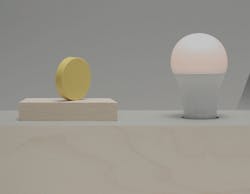Its limited feature line — no colors, for instance — will include a basic entry model that won't do much but that consumers just might find affordable.
After dabbling in smart lighting in continental Europe, home furnishing retail giant IKEA is now bestowing its imprimatur on the concept, broadening its rudimentary line in Europe, introducing it to the US, and in trademark fashion positioning it as more affordable than rival products already on the market.
Interested in articles & announcements on smart lighting?
Helping to keep the wares within a certain price point, the Swedish-inspired, Dutch mass merchandiser excluded at least two features that other smart bulb makers such as Philips Lighting tend to offer: color, and compatibility with Google, Amazon, or Apple voice control systems.
IKEA's new Trådfri line starts as low as £15 ($18.70) in the UK for a single remote-controlled bulb that can dim or brighten via a stylish IKEA handheld “steering wheel.” Unlike more sophisticated smart bulbs, the bulb does not change color temperatures — let alone color. A £29 ($36) version of the same bulb includes three different warmth settings. Neither bulb connects to the Internet or responds to smartphone apps.
IKEA starts the Trådfri smart lighting range with a wirelessly dimming bulb that doesn't change color temperatures. In typical IKEA style, the remote control “wheel” is available in different colors such as yellow.
But at £15 and £29, the limited functionality might hook consumers on smart lighting, which has remained a niche market as consumers balk at much higher price tags for fancier systems, such as the £150 that UK retailers currently charge for a full-color, Internet-connected, voice-capable, three-bulb starter kit version of Philips' Hue line.
The IKEA entry-level bulbs fit existing sockets and do not require any other expenditure. For example, users do not have to first purchase an expensive starter kit the way some vendors require.
At the top of the Trådri line, IKEA is charging £69 ($86) for two variable temperature and dimmable bulbs controllable by a smartphone app that allows personalized settings and presets. Like with the £29 bulb, warmth has three settings — a 2200K warm glow, a 2700K warm white, and a 4000K cool white. The £69 kit includes the two bulbs and an Internet gateway that lets consumers use the Trådri app to control lights from phones or other computers. The system taps ZigBee wireless protocols.
Curiously, the Internet gateway will not initially allow users to control lights from another location via the Internet — a common selling point for smart lighting — although IKEA says it will add that capability in the fall.
IKEA's new Trådfri line generally injects lower prices from a trusted brand into a smart lighting scene characterized by prohibitive tags such as the £150 for Philips' Hue color starter pack, or even the £99 for Philips' two-bulb, variable white starter package, which is £30 more than the £69 Trådri two-bulb kit — although the Philips has more capabilities. Some observers say industry prices could now start to tumble.
Once consumers start to buy basic smart lighting products, they could in turn move up to more advanced wares, prompting the residential smart lighting market to finally gain altitude. An IKEA spokesperson told LEDs Magazine that IKEA plans to eventually add color.
IKEA's Trådri line also includes a £25 motion sensor, as well as various LED light panels and what IKEA calls “light doors” that range in price from £55 to £100.
The company will begin selling Trådfri in the UK, US, and continental Europe in April. It has been offering the non-Internet remote-controlled bulbs in some continental European countries since September, the spokesperson said, adding that IKEA plans to roll out the range in other countries in October.
NOTE: Prices in this story are based on the UK retail market; pricing might be different in other countries.
MARK HALPERis a contributing editor for LEDs Magazine, and an energy, technology, and business journalist ([email protected]).

Mark Halper | Contributing Editor, LEDs Magazine, and Business/Energy/Technology Journalist
Mark Halper is a freelance business, technology, and science journalist who covers everything from media moguls to subatomic particles. Halper has written from locations around the world for TIME Magazine, Fortune, Forbes, the New York Times, the Financial Times, the Guardian, CBS, Wired, and many others. A US citizen living in Britain, he cut his journalism teeth cutting and pasting copy for an English-language daily newspaper in Mexico City. Halper has a BA in history from Cornell University.





